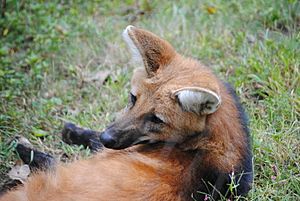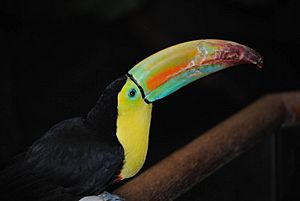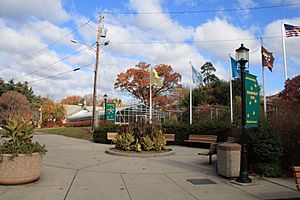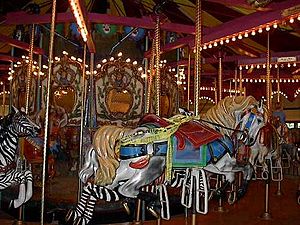Beardsley Zoo facts for kids
 |
|

Maned wolf in the Pampas Plains exhibit.
|
|
| Date opened | March 16, 1922 |
|---|---|
| Location | Bridgeport, Connecticut, United States |
| Coordinates | 41°12′37″N 73°10′53″W / 41.2103°N 73.1815°W |
| No. of animals | 305 |
| No. of species | 110 |
| Annual visitors | 250,000 |
| Memberships | AZA |
The Beardsley Zoo is a fun place to visit in Bridgeport, Connecticut. It's the only zoo in Connecticut that is approved by the AZA. This means it meets high standards for animal care. The zoo also has one of the few carousels in the state, which is a popular ride!
Contents
History of the Zoo and Park
|
Beardsley Park
|
|
| Location | 1875 Noble Ave., Bridgeport, Connecticut |
|---|---|
| Area | 181 acres (73 ha) |
| Architect | Olmsted, Fredrick Law; Northrup, Joseph W. |
| Architectural style | Queen Anne, Modern Movement |
| NRHP reference No. | 98000357 |
| Added to NRHP | March 18, 1999 |
The Park's Beginning
In 1878, a rich farmer named James W. Beardsley gave over 100 acres of land to the city of Bridgeport. He wanted it to be a public park forever. In 1881, the city hired Frederick Law Olmsted to design the park. He was famous for designing New York City's Central Park.
Olmsted thought the land was beautiful and peaceful. He wanted to create a simple, natural park for people to enjoy. He said it was a great place for families to relax away from city life.
How the Zoo Started
Around the time the park was made, P. T. Barnum and his famous circus lived in Bridgeport. Barnum would walk his animals, like zebras and camels, through the streets. People would gather in Beardsley Park to watch them.
In 1920, a city official named Wesley Hayes wanted to start a zoo in the park. He asked people in Bridgeport to donate animals. In the first year, 18 exotic birds were given. By 1927, the zoo had many different animals, including a camel from the Barnum and Bailey Circus.
In 1997, a non-profit group called the Connecticut Zoological Society bought the zoo from the city. They still run the zoo today with help from the state and city.
Zoo Milestones
In 2007, the Beardsley Zoo was the first zoo in the Northeast to show Chacoan peccaries. These are pig-like animals. In 2011, it was also the first in the Northeast to breed them!
In 2010, the world's oldest Andean condor, named Thaao, passed away at the zoo. He had lived there for 17 years.
A special event happened in 2011. An endangered Brazilian ocelot kitten was born at the zoo using a special method called artificial insemination. This was the first time this method worked for an exotic wildcat!
In 2012, the zoo turned 90 years old! They celebrated with special events and a temporary exhibit of giant tortoises. In 2014, the zoo won an award for its amazing education program.
Exhibits and Animals

The Beardsley Zoo has many cool areas to explore:
- Rainforest Building: This indoor building is home to animals from tropical South America. You can see Brazilian ocelots, black howler monkeys, golden lion tamarins, Hoffmann's two-toed sloths, and common vampire bats. There are also colorful birds like scarlet ibis and reptiles like Yacare caiman. In 2015, the building got a "green roof" with plants. This roof helps absorb rainwater and keeps the building cool.
- Predators: Here you can see powerful big cats like Amur tigers and Amur leopards. The zoo plans to build an even bigger tiger home with glass windows for better viewing.
- Alligator Alley: This trail features animals from the Southeastern United States. Look for North American river otters, bald eagles, and American alligators. There's also a small area where you can walk among birds and turtles. Many of these animals were rescued.
- Hoofstock Trail: This long trail has animals from the Great Plains. You'll see plains bison, pronghorn, white-tailed deer, and black-tailed prairie dogs.
- New England Farmyard: This area looks like a small farm. It has farm animals, especially breeds from New England. You can also see wild animals that live in Connecticut. Farm animals include Dexter cattle, llamas, and Guinea hogs. Wild animals include North American porcupines and different kinds of owls.
- W.O.L.F: This exhibit is near the zoo's entrance. It features Mexican wolves and red wolves. The exhibit looks like a trapper's cabin and teaches about how the zoo helps these endangered species. "W.O.L.F" stands for Wolf Observation Learning Facility.
- Native Reptile House: This small building has different reptiles and amphibians that live in Connecticut. You might see black rat snakes, eastern milk snakes, and various turtles and frogs.
- Professor Beardsley's Research Station: This area is mainly for education. It's home to some of the zoo's education animals. The zoo also raises brook trout here to release into the wild.
- Pampas Plains: This new exhibit opened in 2015. It's part of the zoo's "South American Adventure." It has a raised walkway for great views of maned wolves, giant anteaters, Chacoan peccaries, and greater rheas. Baby anteaters have been born here!
- Natt Family Red Panda Habitat: This habitat opened in 2018. It gives the zoo's two red pandas lots of space to play. Visitors have two new spots to watch them.
Near the zoo's entrance, you can see Andean condors. Also, Indian peafowl and Helmeted guineafowl roam freely around the zoo!
The zoo also has a fun carousel and one of the biggest greenhouses in Connecticut. The Victorian Greenhouse has special "century plants" that bloom very rarely, about once every 30 years.
Future Plans
The zoo has exciting plans for the future! They will build a new exhibit called "Spirit of the Cloud Forest." This will bring back Andean bears to the zoo and might include a new home for their condors. They also plan to add spider monkeys to an outdoor area near the Rainforest Building.
Temporary Exhibits
The zoo sometimes has special temporary exhibits. In 2012, they showed Galápagos giant tortoises and Aldabra giant tortoises. In 2014 and 2015, you could even ride dromedary camels! In 2016, four African penguins visited for a few months. In 2017, two baby Amur tiger cubs were born at the zoo, and you could watch them on a webcam!
Conservation Efforts
The Beardsley Zoo works hard to protect animals. They are involved in many conservation programs.
As an AZA-accredited zoo, they take part in captive breeding programs and Species Survival Plans. These plans help increase the numbers of endangered animals. The zoo helps care for and breed species like Amur tigers, Amur leopards, Brazilian ocelots, red wolves, Mexican wolves, maned wolves, and giant anteaters.
The zoo also has a special fund called the Connecticut's Beardsley Zoo Conservation Fund. It gives money to conservation programs around the world. They have supported projects like bear research, protecting lion tamarins in Brazil, and restoring wetlands in Connecticut.
The zoo also releases animals born at the zoo back into the wild. They have helped reintroduce red wolves, golden lion tamarins, Andean condors, and brook trout. They hope to do the same for Mexican wolves soon.
Sometimes, the zoo takes in animals that are injured or orphaned in the wild and can't go back. For example:
- In 2005, a baby white-tailed deer was found alone in Beardsley Park. The zoo took her in.
- In 2010, three bald eagles arrived with wing injuries. They couldn't fly, so they couldn't survive in the wild.
- In 2012, a three-week-old baby bobcat was rescued in Connecticut. The zoo took him in because there was no other place for him. His name is "Beeze," and he helps teach people about bobcats.
Education Programs
The zoo has a great program for high school students called the Conservation Discovery Corps (CDC). Students aged 14–18 learn about science and conservation. They get to work with zoo staff and field biologists. They also help teach zoo visitors about animals and conservation. In 2014, this program won a top award for its success in educating young people.
|
See also
 In Spanish: Zoológico Beardsley de Connecticut para niños
In Spanish: Zoológico Beardsley de Connecticut para niños






